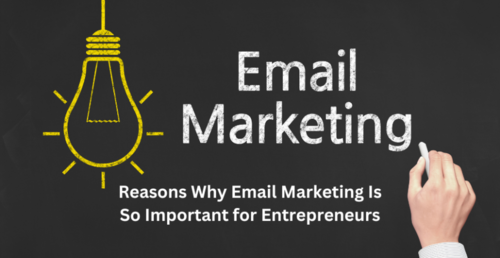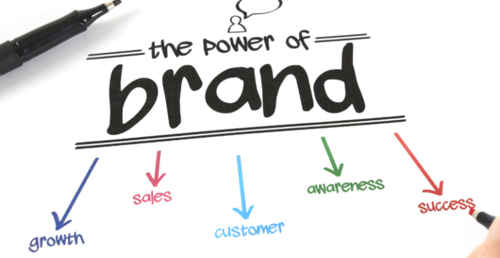
Reasons Why Email Marketing Is So Important for Entrepreneurs

As other digital marketing strategies have evolved, a question that keeps coming up is: “is email marketing still important?”
In short, yes. Creating a strong email marketing strategy helps you reach and connect with your target audience in a personalized way and increase sales at an affordable cost. Just as other platforms and media have changed, email marketing tools give your business the ability to reach customers easier than ever.
Here are my top 9 reasons on the importance of email marketing and how they can help your business:
.png)
Emails have the ability to keep your customers informed. Consumers are capable of checking their email when it is convenient for them. It can give them a feeling that you are thinking of them. This email can be as simple as saying: “Hi, you’re on our mind, here is a special offer!” or “Here is an update on what has been going on here in recent weeks.” Those that have signed up to your email list have already made a commitment to receive these notes. So they will likely enjoy these emails (as long as you give them something worth reading) and it will boost engagement with your customers.
.png)
According to Litmus, 54% of all emails were opened on a mobile device. This is significant and should come into play when planning any marketing strategy. More and more consumers are using their mobile devices to access not only emails but all other types of media and information. Not only that, well-designed emails produce higher conversion rates on mobile than any other medium. Hit ’em on the go!

For a long time now, over 40 years actually, email has been a form of communication. As the years have gone by, email has fast become one of our main choices of communication. We have all been groomed to reply to an email in some fashion. Whether it is to reply, to forward, click through to something else embedded within the email, delete, or to buy something, or to sign up. We tend to do something with the email. Knowing this, you can use email to drive people to your website, to pick up the phone and call or any other call to action. In fact, over 25 percent of sales last year were attributed to email marketing.

Most email marketing tools offer the ability to track what happens after you have sent out your email campaign. You can track delivery rates, bounce rates, unsubscribe rates, click through rates, and open rates. This gives you a better understanding of how your email campaigns are working, which ones to tweak or which ones to get rid of altogether. These metrics should not be ignored. They are an important part of your internet marketing campaign as a whole. While there are various studies and surveys that present “optimal” numbers to aim for, it all depends on your industry and target audience. If your customers not only want but expect daily emails, you better provide them. However, sending too many emails to consumers who don’t want more than one a week will see your unsubscribe rate increase. It’s all about knowing your customers and providing valuable content.

Yes, we know you were waiting for us to address this one. You can reach a large number of consumers for less than pennies per message. The cost per (possible) conversion is so low with email marketing, I cannot believe every company does not participate, or engage more often.
Email marketing services such as SendGrid costs $0.0006 cents per message at their Platinum Marketing Email level. Mail Chimp allows you to send up to 12,000 emails a month for free. They also do offer larger monthly plans for growing businesses with up to 600,000 subscribers and high volume sender plans for anything over that. Another email marketing company, Vertical Response, offers free email marketing up to 4,000 emails a month and 1,000 email contacts. They also offer subscription services for higher-volume senders.
So, yes, while it does offer a significant ROI, it might be a wise idea to hire someone to manage these efforts. According to Shout It Out Designs, at a 15,000 email database, your company would spend about 152 hours per year managing the campaign. This would include writing, drafting, scheduling, sending, etc. of the emails, answering any questions about offers, missing coupons or other concerns and database maintenance: adding and deleting members, updating information and other tasks.

Now let’s talk about the importance of email marketing when it comes to lead nurturing – sometimes referred to as email lead marketing. The main idea here is that your potential customers are at different stages of the buying cycle. Some may be in the consideration stage, while others may be at the research and compare stage, and even others in the ready-to-purchase stage. Creating buyer personas can help you determine what kind of content to create for each step.
Segmenting these customers into appropriate email marketing lists helps businesses target these groups more effectively. Customers need information to move them to the next buying cycle stage; pushing the right content can do just that. It’s all about moving these prospects down your sales funnel – not as quickly as possible, but as efficiently as possible.

Nope, social media isn’t the only platform that helps a company’s brand awareness. Possessing a customer or prospect’s email address means one thing: they showed a level of interest in your business. Email marketing gives you the ability to increase that interest level, that brand awareness, by staying top of mind.
This doesn’t mean to send four daily emails to every single customer. That’s actually a great way to get customers to hate you… Instead, try some email marketing that promotes your activeness in the local community. Too many times companies try to sell, sell, sell their products via email marketing, and completely ignore the brand awareness factor. By doing so, they’re also prohibiting the ultimate possibility of building customer trust and adding a sense of personality to their brand.

Speaking of sell, sell, sell…
Yes, one of the benefits of email marketing can be to sell your products, if you approach it in the correct fashion. It’s important to use all the customer data and information you can. Sending customers a special offer on their birthday, or letting them know their favorite dish is half off is much more effective than simply sending them a menu.
This email marketing strategy also can incorporate seasonal offers, allowing you to promote a holiday special or an annual sale. Be sure to create a sense of urgency for any offer – customers are much more likely to purchase when a deal is ending soon.
%20uses%20email.png)
A Hubspot survey states that 91% of consumers use email. That alone should be enough to convince you to explore the tool. Unless your industry accounts for the remaining 9% (hint: it doesn’t), email presents an incredible opportunity to reach customers. Not only can you provide them with discounts, specials, new products, and more, they can share and forward those emails to anyone they’d like. A good email marketing strategy is to encourage customers to share offers as much as possible. Remember brand awareness?
Email is especially huge in the B2B world as it accounts for the most prominent form of communication for 73% of businesses.
Also Read : How to Optomize your Email Marketing campains
(7).jpg)
About: Andries vanTonder
Over 40 years selfemployed
He is a Serial Entrepreneur, an Enthusiastic supporter of Blockchain Technology and a Cryptocurrency Investor
Find me at my Markethive Profile Page | My Twitter Account | My Instagram Acount | and my Facebook Profile.
